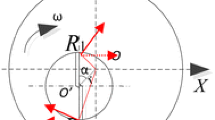Abstract
The reverse computation methodology is proposed to obtain the process parameters for force specifications. A physics-based model along with an iterative gradient search method is employed to design the process parameters such as cutting velocity and depth of cut from the experimentally determined cutting forces. In order to obtain the desired cutting forces, it is required to have a systematic approach to determine the process parameters. An iterative gradient search procedure based on Kalman filter is set up to adaptively approach the specific forces by the optimization of process parameters such that an inverse reasoning can be achieved. A physics-based model is used to predict the cutting forces in each iteration based on shear deformation and chip formation model, as proposed by Oxley. The experimental data are used to illustrate the implementation and validate the viability of the computational methodology.
Similar content being viewed by others
References
Kumar KK, Choudhury S (2008) Investigation of tool wear and cutting force in cryogenic machining using design of experiments. J Mater Process Technol 203(1):95–101
Kuljanic E, Sortino M (2005) TWEM, a method based on cutting forces—monitoring tool wear in face milling. Int J Mach Tools Manuf 45(1):29–34
Özel T, Karpat Y (2005) Predictive modeling of surface roughness and tool wear in hard turning using regression and neural networks. Int J Mach Tools Manuf 45(4):467–479
Saffar RJ et al (2008) Simulation of three-dimension cutting force and tool deflection in the end milling operation based on finite element method. Simul Model Pract Theory 16(10):1677–1688
Su, J.-C.,(2006) Residual stress modeling in machining processes. Georgia Institute of Technology
Strenkowski JS, Carroll J (1985) A finite element model of orthogonal metal cutting. J Eng Ind 107(4):349–354
Yen Y-C, Jain A, Altan T (2004) A finite element analysis of orthogonal machining using different tool edge geometries. J Mater Process Technol 146(1):72–81
Umbrello D (2008) Finite element simulation of conventional and high speed machining of Ti6Al4V alloy. J Mater Process Technol 196(1):79–87
Shao Y, Li B, Chiang KN, Liang SY (2015) Physics-based analysis of minimum quantity lubrication grinding. Int J Adv Manuf Technol 79:1659–1670
Karpat Y, Özel T (2006) Predictive analytical and thermal modeling of orthogonal cutting process—part I: predictions of tool forces, stresses, and temperature distributions. J Manuf Sci Eng 128(2):435–444
Barry J, Byrne G (2001) Cutting tool wear in the machining of hardened steels: part I: alumina/TiC cutting tool wear. Wear 247(2):139–151
Oxley, P.L.B.,(1989) The mechanics of machining: an analytical approach to assesing machinability. Ellis Horwood
Budak E, Altintas Y, Armarego E (1996) Prediction of milling force coefficients from orthogonal cutting data. J Manuf Sci Eng 118(2):216–224
AOKI H et al (1997) Use of alternative protein sources as substitutes for fish meal in red sea bream diets. Aquac Sci 45(1):131–139
Bocciarelli M, Bolzon G, Maier G (2005) Parameter identification in anisotropic elastoplasticity by indentation and imprint mapping. Mech Mater 37(8):855–868
Nakamura EF, Loureiro AA, Frery AC (2007) Information fusion for wireless sensor networks: methods, models, and classifications. ACM Comput Surv(CSUR) 39(3):9–es
Delalleau A, Josse G, Lagarde JM, Zahouani H, Bergheau JM (2006) Characterization of the mechanical properties of skin by inverse analysis combined with the indentation test. J Biomech 39(9):1603–1610
Pan, Z., Shih D.S., Garmestani H., Liang S.Y., Residual stress prediction for turning of Ti-6Al-4V considering the microstructure evolution. Proc Inst Mech Eng B J Eng Manuf, 2017: p. 0954405417712551, 095440541771255
Komanduri R, Hou ZB (2001) Thermal modeling of the metal cutting process—part III: temperature rise distribution due to the combined effects of shear plane heat source and the tool–chip interface frictional heat source. Int J Mech Sci 43(1):89–107
Author information
Authors and Affiliations
Corresponding author
Rights and permissions
About this article
Cite this article
Mirkoohi, E., Bocchini, P. & Liang, S.Y. An analytical modeling for process parameter planning in the machining of Ti-6Al-4V for force specifications using an inverse analysis. Int J Adv Manuf Technol 98, 2347–2355 (2018). https://doi.org/10.1007/s00170-018-2393-z
Received:
Accepted:
Published:
Issue Date:
DOI: https://doi.org/10.1007/s00170-018-2393-z



